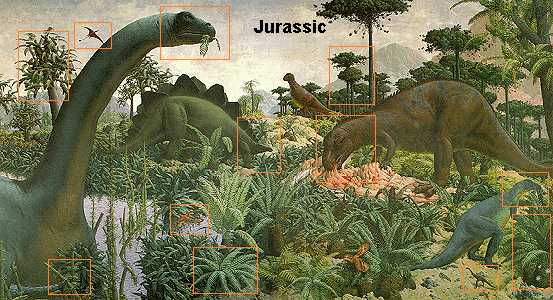
Continental conditions of the Triassic Period continued into the Jurassic interval in many places around the world. Climates continued to be near-tropical, and dinosaurian evolution introduced an impressive roster of cast members -- most new and very different from the smaller and less famous company that preceded them -- ranging from the huge sauropods to the tiny birdlike predators. Among the saurischian dinosaurs abundant during Jurassic times were the carnivorous or theropod dinosaurs such as Allosaurus or Antrodemus and the very small chicken-sized predator Compsognathus. Other saurischians were the well-known sauropods, including the plant-eating and possibly swamp-dwelling Brontosaurus or Apatosaurus, as it should be called (scientists now think that Brontosaurus and Apatosaurus were one and the same animal, but the former name remains in widespread use).
Although some changes are apparent in the vegetation of the Jurassic, especially a diminution in the importance of seed ferns in Southern Hemisphere areas not shown on the mural, for the most part the period represents a continuation of lines already well established in Triassic times. Some cycadeoids, such as Williamsonia, had attained the stature of moderately tall trees with crowns of divided, palmlike leaves.
|
|